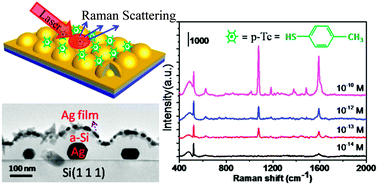Bottom-up growth of Ag/a-Si@Ag arrays on silicon as a surface-enhanced Raman scattering substrate with high sensitivity and large-area uniformity†
Abstract
In this work, we demonstrated a bottom-up growth of Ag/a-Si@Ag nanosphere arrays on Si to work as a high performance SERS substrate. By a solid-state dewetting process, high density Ag nanoparticle arrays were formed on the Si substrate with large-area uniformity. With well-controlled thicknesses of a-Si and Ag outer-layer coating, the SERS properties can be optimized with the inter-particle spacing of the Ag/a-Si@Ag NSs limited to several nanometers. Based on the analysis of optical properties and SERS activities to p-Tc molecules, we concluded that the optimized SERS substrate performed with both high sensitivity and large-area uniformity. A detection limit as low as 10−14 M and an enhancement factor (EF) up to 108 were obtained. Furthermore, the wafer scale large-area uniformity and reproducibility of the SERS signal were confirmed with small standard deviation, e.g., 8% at 1076 cm−1 and 9% at 1593 cm−1. The generic approach presented here can be extended to create a new class of highly sensitive SERS sensors with large-area output, and may play an important role in device design and the corresponding diverse chemical and biological detection tasks.


 Please wait while we load your content...
Please wait while we load your content...